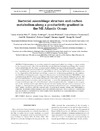Please use this identifier to cite or link to this item:
http://hdl.handle.net/10553/51654
| Title: | Bacterial assemblage structure and carbon metabolism along a productivity gradient in the NE Atlantic Ocean | Authors: | Alonso-Sáez, Laura Arístegui, Javier Pinhassi, Jarone Gómez-Consarnau, Laura González, José M. Vaqué, Dolors Agustí, Susana Gasol, Josep M. |
Keywords: | Bacteria Atlantic Ocean Diversity Metabolism CARD-FISH, et al |
Issue Date: | 2007 | Publisher: | 0948-3055 | Project: | COCA(REN2000 1471-CO2-O1-MAR) DEBACOCA (REN2001-4211-E) MICRODIFF (REN2001-2120/MAR) BASICS (EVK3-CT-2002-00078) GENMUMAR (CTM2004-02586/MAR) |
Journal: | Aquatic Microbial Ecology | Abstract: | Bacterioplankton have the potential to significantly affect the cycling of organic matter in the ocean; however, little is known about the linkage between bacterial assemblage structure and carbon metabolism. In this study, we investigated whether changes in the phylogenetic composition of bacterioplankton were associated with changes in bacterial carbon processing (bacterial production, respiration and biomass) in the subtropical NE Atlantic Ocean. We found consistent differences in the composition of the bacterial assemblage, as revealed by denaturing gradient gel electrophoresis (DGGE) and catalyzed reporter deposition-fluorescence in situ hybridization (CARD-FISH), along a gradient from the NW African upwelling to the oligotrophic North Atlantic Subtropical Gyre. The percent contribution of Bacteroidetes, Roseobacter and Gammaproteobacteria significantly increased towards more productive waters, whereas the SAR11 clade of the Alphaproteobacteria remained relatively constant (average 28% of DAPI-stained cells) throughout the area. Changes in the composition of the bacterial assemblage detected by DGGE were weakly but significantly correlated with changes in carbon processing variables. The abundances of Roseobacter and Gammaproteobacteria were highly correlated with the concentration of particulate organic carbon and chlorophyll a, reflecting the affinity of these groups to nutrient-enriched conditions. The abundance of Roseobacter was also positively correlated with heterotrophic bacterial production, suggesting their active participation in carbon processing. | URI: | http://hdl.handle.net/10553/51654 | ISSN: | 0948-3055 | DOI: | 10.3354/ame046043 | Source: | Aquatic Microbial Ecology [ISSN 0948-3055], v. 46, p. 43-53 |
| Appears in Collections: | Artículos |
SCOPUSTM
Citations
66
checked on May 26, 2024
WEB OF SCIENCETM
Citations
66
checked on May 26, 2024
Page view(s)
69
checked on Mar 2, 2024
Download(s)
91
checked on Mar 2, 2024
Google ScholarTM
Check
Altmetric
Share
Export metadata
Items in accedaCRIS are protected by copyright, with all rights reserved, unless otherwise indicated.
